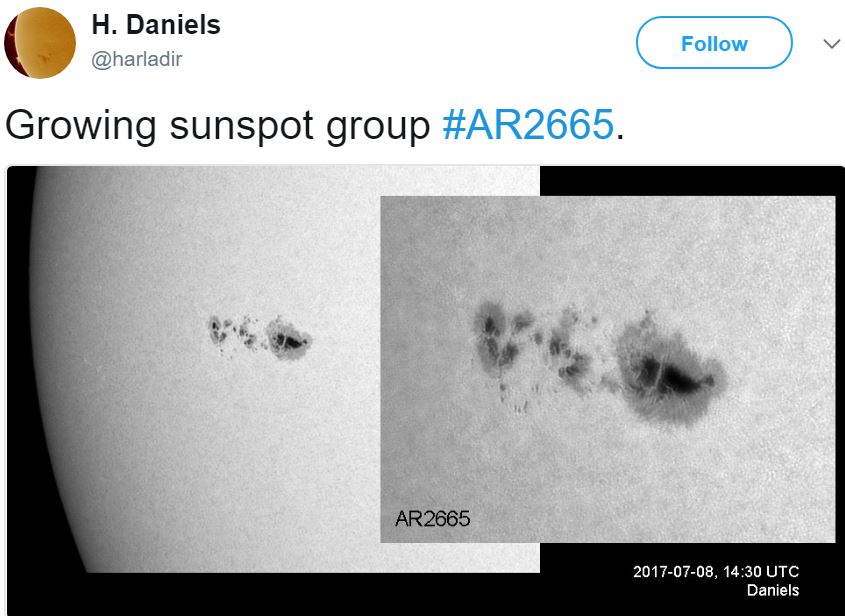A huge sunspot that appeared on the Sun’s surface could be dangerous, scientists warn – it could produce a solar flare capable of damaging our artificial satellites. We use satellites for many purposes – there are military and Earth observation satellites, navigation satellites, space telescopes, weather satellites, and communications satellites.
If our satellite systems were knocked out, the consequences could be serious.
NASA’s Solar Dynamics Observatory (SDO), which orbits the Earth and has been observing the Sun since 2010, has detected a huge sunspot, called AR2665.
Huge sunspot much bigger than Earth
This sunspot is approximately nineteen times larger than Earth – it is 74,560 miles wide. Scientists are concerned that this huge sunspot is unstable enough to produce the largest type of solar flare, known as an M-Class flare.
 Photographers across the world have been capturing some spectacular images of AR665, the huge sunspot. (Image: twitter.com/harladir)
Photographers across the world have been capturing some spectacular images of AR665, the huge sunspot. (Image: twitter.com/harladir)
An M-Class solar flare is capable of knocking out our satellites, which would not only cause havoc to human activities on Earth, but could potentially place astronauts living aboard the International Space Station in danger.
A Cornell University website called Ask an Astronomer, says the following regarding solar flares and the health of astronauts and airplane pilots:
“There are also health issues for airline pilots and astronauts. For those of us that spend most of our time on the ground, the magnetic field and the atmosphere block out almost all of the harmful radiation and charged particles.”
“This is not the case when you go up in the atmosphere. Airline pilots that fly at great altitude, and especially near the poles, are exposed to more of these.”
“The same goes for astronauts. This results in a higher incidence of cancer among airline pilots and cabin crew. Astronauts have even reported seeing flashes of light because of high energy protons hitting their eyes!”
NASA’s Goddard Space Flight Center, in Greenbelt, Maryland, explained in a press release that an active region of our Sun – an area of very intense and complex magnetic fields – has rotated into view and appears to be growing rapidly (see video at the bottom of this page).
This type of sunspot is less common in the current period of low solar activity during the Sun’s regular 11-year cycle.
The Goddard Space Flight Center wrote, regarding this sunspot:
“This sunspot is the first to appear after the sun was spotless for two days, and it is the only sunspot group at this moment. Like freckles on the face of the sun, they appear to be small features, but size is relative.”
By ‘small features’, scientists mean relative to the Sun. When compared to the size of our planet, it really is a huge sunspot.
 In this photograph, you can see the huge sunspot – AR2665 – just in front of the nose of the airplane. (Image: spaceweathergallery.com. Credit: Bruno Boni de Oliveira)
In this photograph, you can see the huge sunspot – AR2665 – just in front of the nose of the airplane. (Image: spaceweathergallery.com. Credit: Bruno Boni de Oliveira)
Can I see this huge sunspot?
This sunspot should be easily visible for astronomy enthusiasts whose backyard telescopes are equipped with solar filters.
SpaceWeather.com made the following comment:
“Big sunspot AR2665 has decayed a little during the past 24 hours. Nevertheless, it still has an unstable magnetic field that poses a threat for moderately strong solar flares.”
“NOAA forecasters say there is a 25% chance of M-class flares on July 12th. Any explosions would be geoeffective as the sunspot is directly facing our planet.”
The size of this huge sunspot makes it an unusually photogenic phenomenon. Photographers across the world have been capturing some fantastic images.
SpaceWeather.com quoted Boni de Oliveira, who said:
“On July 11th, summer haze and NYC pollution allowed me properly expose the sun at a good angle for the busy air traffic route, just a few minutes before the sunset.”
“As I focused, surprise: There was a sunspot! I quickly checked SpaceWeather.com to find out it was the huge AR2665.”
What is a sunspot?
A sunspot is a region on the Sun’s photosphere (surface) that is temporarily cooler and darker than the surrounding regions.
The average temperature of the Sun’s surface is 6000° Celsius, while sunspots are approximately 1500° Celsius cooler.
#Sun‘s eastern limb prominence’s and active group #AR2665 – #Solar-Ha imaging with @daystar_filters Quark CS – #Manchester #stockport pic.twitter.com/cqK155kpaX
— Mark Forbes (@SCN_ZBOYD) July 9, 2017
A sunspot can last anywhere from a couple of hours to several months. As they move across the Sun’s surface they expand and contract.
Sometimes there are many sunspots on the Sun’s surface, while at other times none are visible. German chemist and amateur astronomer, Heinrich Schwabe (1789-1875), discovered in 1843 that there was a regular cycle of change in the number of sunspots on the Sun’s surface, and that this cycle lasted approximately eleven years.
The ‘solar minimum’ is the period during the cycle when sunspot activity is very low, while ‘solar maximum’ is the period with high activity.
According to EarthObservatory.NASA.gov:
“Sunspots are magnetic regions on the sun with magnetic field strengths thousands of times stronger than the Earth’s magnetic field, and often appear in pairs that are aligned in an east-west direction.”
“One set will have a positive or north magnetic field while the other set will have a negative or south magnetic field. The field is strongest in the darker parts of the sunspots – called the umbra.”
“The field is weaker and more horizontal in the lighter part—the penumbra. Overall, sunspots have a magnetic field that is about 1000 times stronger than the surrounding photosphere.”
Video – Huge sunspot turns towards Earth
In this NASA Goddard video, you can see the enormous sunspot turning towards Earth.
